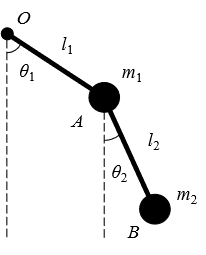In recent years, energy harvesters using pendulum systems have often been applied in ultra-low-frequency environments, such as ocean waves, human motion, and structural vibration. To illustrate the research progress in pendulum-type energy harvesting, a comprehensive review is provided in the present study. Specifically, single- and double-pendulum energy harvesters based on different energy-conversion mechanisms are separately grouped. In addition, different improvement techniques and design schemes used in studies on pendulum energy harvesters are summarized.
- vibration energy harvesting
- single pendulum
- double pendulum
1. Introduction
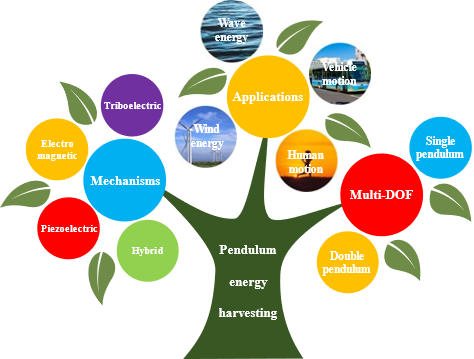
Figure 1. Classification of pendulum energy harvesting technologies.
2. Energy harvesters with a single pendulum
Single pendulum is a classic nonlinear dynamic model. Studies on single pendulums have a long history. Compared with other structures, such as cantilever beams, a single pendulum exhibits different characteristics. Parametric resonance is a form of vibration that can be applied to energy harvesting. Unlike direct resonance, parametric resonance does not saturate due to linear damping [40]. However, damping may affect the initiation threshold amplitude. To solve this problem, Jia et al. [41] applied a pendulum structure for electromagnetic energy harvesting. The application of a pendulum structure can reduce the resonance amplitude threshold. In addition, some studies have shown that pendulum structures produced satisfactory effects on low-frequency and broadband energy-harvesting performance [42]. Dai et al. [43] equipped a vibration-energy harvester with a single pendulum. The authors established a theoretical model of the structure and calculated the ratio between the half-peak bandwidth and center frequency. Their analysis revealed that the bandwidth of the pendulum energy harvester was broadened. From the above analysis, the pendulum structure is suitable for increasing the conversion efficiency of the energy harvester under low-frequency conditions and for broadening the bandwidth.
Figure 6a shows the primary structure of the system, comprising a tuned-mass damper and two independent energy-harvesting devices. The effects of magnetic levitation and rotating harvesters on vibration absorption have been analyzed. In addition to the performance of pendulum systems, their applications in vibration mitigation and energy conversion have been explored. For instance, structural vibration is a significant problem occurring during the operation of offshore wind turbines (OWTs) [60]. Therefore, OWTs have been equipped with various structures to absorb vibration. Jahangiri et al. [61] utilized an electromagnetic generator to replace a linear damper for energy harvesting. They developed a three-dimensional pendulum structure that could absorb vibrations and harvest energy in both x and y directions. The schematic is shown in Figure 6b. When the wind turbine vibrates, the swing of the pendulum induces the relative motion of the coils and magnets. Simulation results indicated that displacement of the nacelle was reduced by approximately 70% and 77% in the axial and radial directions, respectively. Shen et al. [62] proposed a self-powered vibration reduction and monitoring system based on a pendulum structure. The primary structure is shown in Figure 6c.
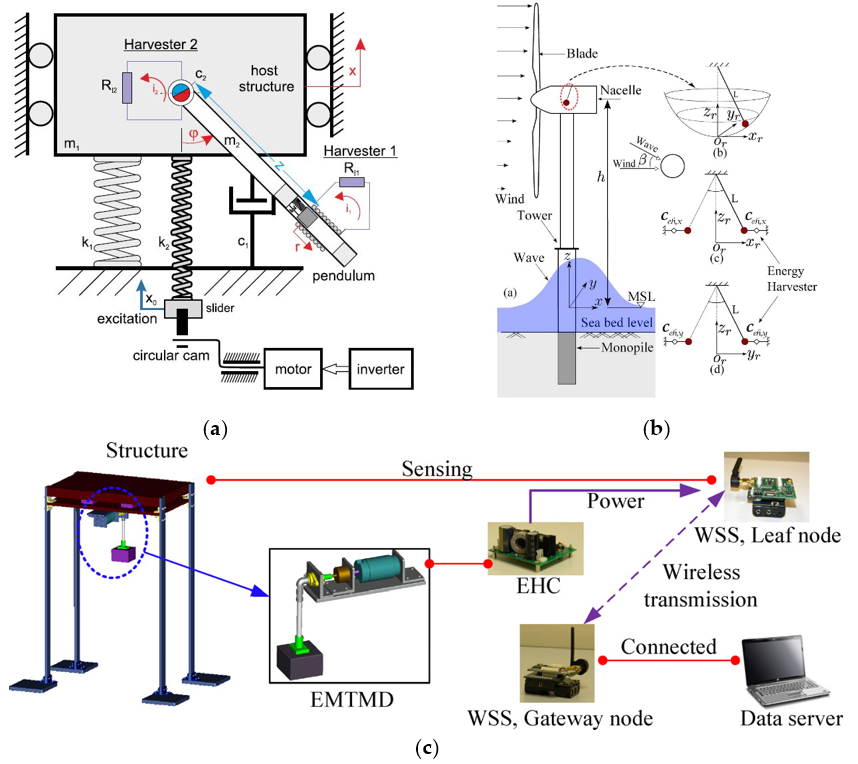
Figure 6. (a) Electromagnetic energy harvester with a pendulum-tuned mass damper [59]. Reprinted with permission from Ref. [59]. Copyright 2020, Elsevier. (b) OWTs with a pendulum-tuned mass damper [61]. Adapted with permission from Ref. [61]. Copyright 2019, Elsevier. (c) Self-powered vibration reduction and monitoring system [62]. Reprinted with permission from Ref. [62]. Copyright 2012, Elsevier.
As shown in Figure 9a, the proposed system could be applied to convert the inertial kinetic energy of driverless buses. Experimental results showed that the harvester could generate the maximum output power of 1.233 mW, and it could harvest multiple types of kinetic energy to self-powered sensors of driverless buses. This was confirmed in another similar study [81]. Additionally, Shukla et al. [82] developed a pendulum energy harvester (Figure 9b) that can be equipped on the human body to capture energy from waistline movement. The pendulum comprises multiple strikers that can bend compliant piezoelectric units. The maximum output power could reach 290 μW with PVDF units when the strikers were separated by 23 mm. Bao et al. [83] designed a handheld human motion energy harvester, as shown in Figure 9c. According to the inertial pendulum principle, the magnetic rotor can rotate and capture kinetic energy when the human body moves. Treadmill experiments revealed that the proposed structure could generate average power of 0.18μW 6 km·h-1.
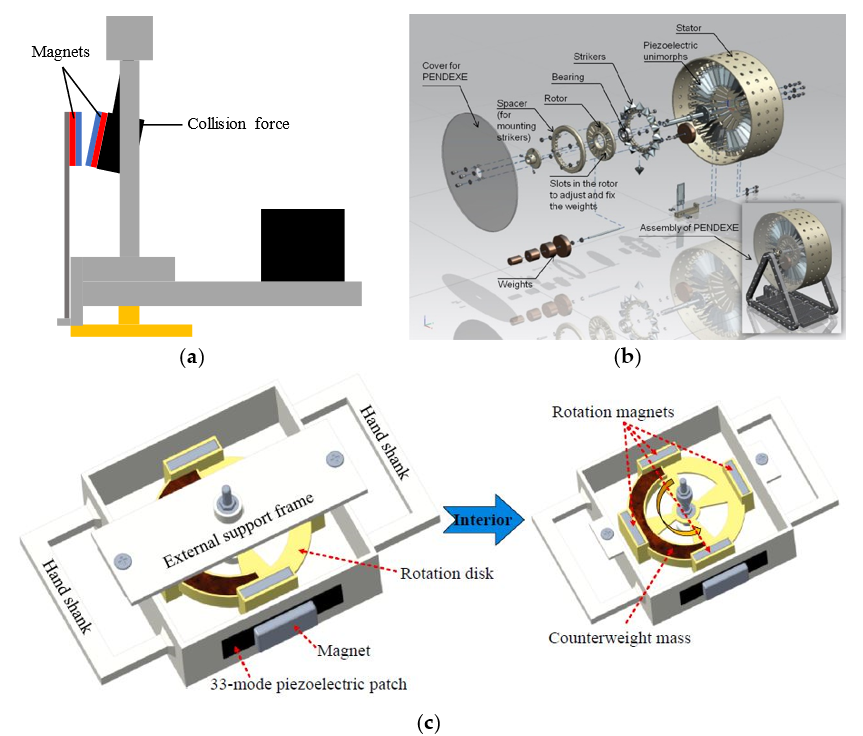
Figure 9. (a) Multi-directional pendulum kinetic energy harvester [80]. (b) Human waistline movement energy harvester [82]. (c) Hand-held human motion energy harvester [83].
Wu et al. [84] presented a frequency-up-converting harvester based on a pendulum component, as shown in Figure 10a. Specifically, they designed a 1:2:6 internal resonance mechanism to efficiently capture the ambient mechanical energy with a low vibration frequency. The energy-harvesting power of the piezoelectric energy harvester was approximately 2 mW at an excitation frequency of 2 Hz and 0.37 g. The proposed harvester exhibited excellent performance and significantly increased energy conversion efficiency in the low-frequency range. In another study, Fan et al. [85] developed a pendulum ball impact-excited piezoelectric energy converter to harvest low-frequency vibrations. Figure 10b shows the primary structure. Further, the performance of the single- and double-pendulum ball structures was compared. Experimental results showed that the output power of the double-pendulum ball structure is 43 μW at the vibration frequency of 2 Hz. Moreover, the output power of the harvester was effectively improved in a low-frequency environment, exhibiting immense application potential in low-frequency energy harvesting. Further, Pan et al. [86] developed a piezoelectric energy harvester comprising an inverted piezoelectric beam and pendulum. The mode coupling in the structure was beneficial for producing a snap-through motion. The maximum power of the harvester was 51.6 μW at stochastic excitations. Li et al. [87] investigated a harvester comprising a horizontally placed cantilever beam and pendulum. In this structure, the pendulum was able to swing freely under excitation and induce the dynamic buckling of the beam. The response of the harvester was analyzed under harmonic and random excitations. Furthermore, to increase conversion efficiency, multi-directional energy harvesting has become another optimization method for the pendulum structure. As such, Bao et al. [88] proposed a magnetic pendulum piezoelectric energy harvester for multidirectional energy harvesting, as shown in Figure 10c. In that study, internal resonance was induced through nonlinear coupling between the magnetic pendulum and cantilever beam. This harvester could capture vibrational energy in multiple directions through internal resonance. Experimental results indicated that the structure could generate the maximum output power of 0.64 mW at 7.5 Hz. Xu et al. [89] investigated a multidirectional energy harvester based on a pendulum ball that can freely swing in three-dimensional space (Figure 10d). Nonlinear coupling between the cantilever and pendulum ball enabled the conversion of vibrational energy in multiple directions, and this system showed a simpler structure and higher efficiency than conventional designs with multiple cantilever beams. Mo et al. [90] designed a piezoelectric energy harvester based on a U-shaped beam and pendulum. This harvester was able to capture multidirectional vibrational energy and operate at a low frequency.
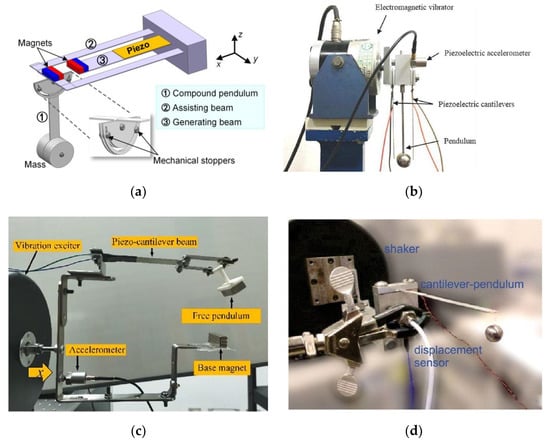
3. Energy harvesters with double pendulum
A double pendulum adds a degree of freedom to the basis of a single pendulum. However, a double pendulum exhibits complicated motion and rich dynamics [107]. Thus, double pendulums have attracted much research attention. A double pendulum comprises two rigid pendulae that can swing freely in the vertical plane. The primary structure of the double pendulum is shown in Figure 15.
Figure 15. Primary structure of double pendulum
Chen et al. [119] proposed a rotational wind energy harvester based on a magnetic double-pendulum system. As shown in Figure 18a, the proposed structure generates electric power by coupling the double pendulum with nonlinear magnetic interaction. Owing to the dynamic characteristics of the double pendulum, this system can reduce the magnetic resistance torque at low rotational speeds. Experimental results indicated that the system was able to generate the maximum output power of 1.25 mW at a rotational speed of 557.31 rpm. Izadgoshasb et al. [120] applied a double pendulum system to human motion energy harvesting, as shown in Figure 18b. The piezoelectric cantilever beam is driven by a double pendulum through magnets. The authors compared three configurations using the mechanical shaker and human motion tests: cantilever beam, single pendulum, and double pendulum. The double pendulum exhibited the best effect. Sun et al. [121] expanded the bandwidth of a piezoelectric energy harvester by utilizing the internal resonance between the double pendulum and cantilever beam (Figure 18c). The experimental results showed that the double-pendulum harvester showed excellent broadband energy harvesting ability. Selyutskiy et al. [122] designed a flow-induced vibration energy harvester based on a double aerodynamic pendulum. In this system, the piezoelectric element is connected to the first pendulum and undergoes deformation under the rotation of the pendulum (Figure 18d). This harvester may be suitable for wind energy harvesting.
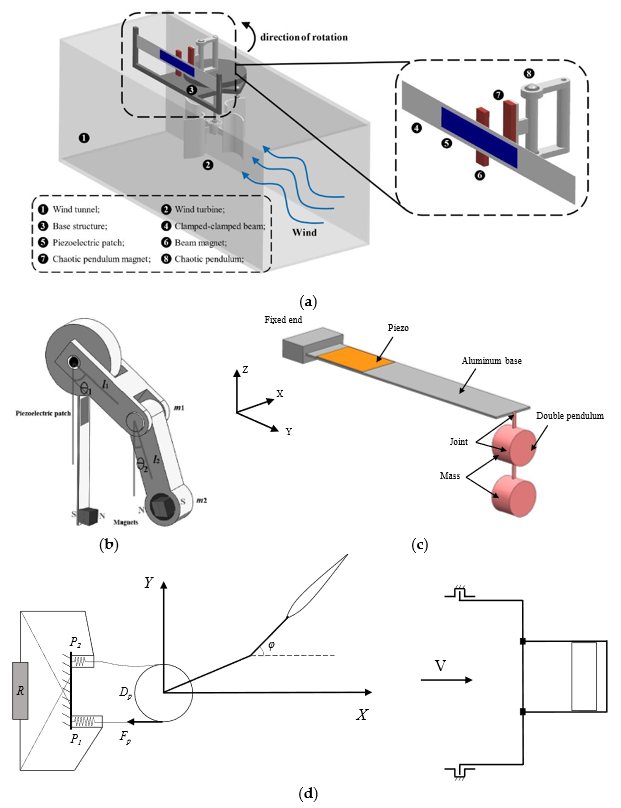
Figure 18. (a) Rotational wind energy harvester based on magnetic double pendulum [119]. (b) Double-pendulum energy harvester applied in human motion energy conversion [120]. Reprinted with permission from Ref. [120]. Copyright 2019, Elsevier. (c) Piezoelectric cantilever beam coupled with double pendulum [121]. (d) Flow-induced vibration energy harvester based on double aerodynamic pendulum [122].
4. Discussion
Table 1 summarizes studies on pendulum energy harvesters, primarily including the conversion mechanism, application, working conditions, and output power. In general, studies on the single pendulum are dominant, although a few studies have explored double pendulums. Overall, the double-pendulum systems showed better performance in energy harvesting than the single-pendulum system [114,115]. Thus, research on energy harvesters based on double-pendulum systems warrants further advancement. In particular, pendulum system energy harvesters are primarily applied for the conversion of ultra-low-frequency energy, such as oceanic kinetic and human motion energy. The output power of pendulum-like energy harvesters is mainly concentrated at the milliwatt and microwatt levels, which is suitable for low-power devices.
Table 1. Comparison of various energy harvesters based on pendulum systems.

5. Conclusions
This study reviews the researches on the theoretical analyses of single and double pendulums and their applications in energy harvesting. The different energy-conversion mechanisms, design schemes, and optimal structures of pendulum-like energy harvesters have been summarized in the literature. Based on the existing research, single-pendulum energy harvesters are predominantly applied in ultra-low-frequency environments and for multi-directional energy harvesting. The working conditions of pendulum energy harvesters are <10 Hz, which mainly include ocean wave and human motion energy. Furthermore, single-pendulum systems can be combined with other functions, such as mechanical motion rectifiers and structural damping. In addition, energy harvesting based on double pendulums has attracted much research attention. Based on the above summary, we predict several future research directions and potential applications of pendulum-type energy harvesters:
- From comparative experimental results, double-pendulum systems perform better than single-pendulum systems in terms of energy harvesting. However, studies on double-pendulum energy harvesters are relatively few, and research on energy harvesters based on double pendulums may be further advanced.
- The combination of a nonlinear structure with a pendulum system energy harvester has been considerably optimized. The introduction of a nonlinear structure can improve the adaptive ability of energy harvesters. From the current studies, the energy harvesting performance can be effectively improved with the reasonable application of nonlinear systems.
- Multi-physics coupling energy harvesting is another research topic. The coupling of different types of energy conversion mechanisms can broaden the operation bandwidth and improve output power.
This entry is adapted from the peer-reviewed paper 10.3390/en15228674

